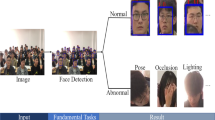Abstract
Remote network teaching has gained significant importance in recent times, with video images serving as a crucial medium for delivering educational content. Ensuring accurate face recognition in these video images is a key challenge. To address this, we present a face recognition algorithm based on an improved frame difference method. The algorithm focuses on enhancing the accuracy of face recognition specifically in remote network teaching video images. By leveraging a generative adversarial network method, we enhance image resolution as a preprocessing step. Subsequently, our proposed image target detection algorithm effectively identifies the face region through foreground and background segmentation. We employ an improved local three-value pattern for face feature extraction, concentrating on the face target region. These features are then input into an integrated neural network face recognition model. Experimental results demonstrate the algorithm's efficacy in enhancing clarity processing, facial object detection, and feature extraction for remote teaching video images. Notably, the proposed method achieves an average gradient of details below 0.1 and attains a facial feature matching degree of 0.98, establishing the high accuracy of facial recognition results in remote teaching video images.










Similar content being viewed by others
References
Xue S, Ren HP (2022) Single sample per person face recognition algorithm based on the robust prototype dictionary and robust variation dictionary construction. IET Image Proc 16(3):742–754
Liu S, Huang S, Fu W, Lin JCW (2022) A descriptive human visual cognitive strategy using graph neural network for facial expression recognition. Int J Mach Learn Cybernet. https://doi.org/10.1007/s13042-022-01681-w
Neha S, Khular SE, Amita K (2021) Hybrid meta-heuristic algorithm based Deep Neural Network for Face Recognition. J Comput Sci 30(11):14–15
Tsoni R, Sakkopoulos E, Panagiotakopoulos CT (2021) On the equivalence between bimodal and unimodal students’ collaboration networks in distance learning. Intell Decis Technol 15(2):305–319
Kamber DN (2021) Personalized distance-learning experience through virtual oral examinations in an undergraduate biochemistry course. J Chem Educ 98(2):395–399
Wang L, Xu Z (2021) An english learning system based on mobile edge computing constructs a wireless distance teaching environment. Mob Inf Syst 2021(1):1–9
Kapanadze T (2021) how to enhance the effectiveness of the learning process during distance learning. Psychologist recommendations. J Leg Stud “Vasile Goldiş” 28(42):42–57
Gómez-Silva MJ, Escalera S, Armingol JM (2021) Back-propagation of the Mahalanobis distance through a deep triplet learning model for person Re-Identification. Integr Comput-Aided Eng 28(3):1–18
Liu YQ, Zhao HW, Wang Y (2020) Video face recognition method based on QPSO and manifold learning. Acta Autom Sin 46(02):256–263
Wang HX, Hu YY, Deng C (2021) Research and implementation of face recognition algorithm based on LBP and ELM. J Henan Polytechnic Univ (Nat Sci) 40(05):139–145
Liu X, Chen S, Song L, Woźniak M, Liu S (2022) Self-attention negative feedback network for real-time image super-resolution. J King Saud Univ – Comput Inf Sci 34(8B):6179–6186
Imanpour N, Naghsh NAR, Monadjemi A, Karshenas H, Nasrollahi K, Moeslund TB (2021) Memory and time efficient dense network for single image super resolution. IET Signal Proc 15(2):141–152
Liu S, Huang S, Xu X, Lloret J, Muhammad K (2023) Efficient visual tracking based on fuzzy inference for intelligent transportation systems. IEEE Trans Intell Transp Syst. https://doi.org/10.1109/TITS.2022.3232242
Sun LC, Feng HZ (2022) Image clarity processing based on encoding quantization parameter adjustment. Comput Simul 39(04):180–184
Chen Y, Cheng N, Cai M, Cao C, Yang J, Zhang Z (2021) A spatially constrained asymmetric Gaussian mixture model for image segmentation. Inf Sci 575(10):41–65
Van Hook RL, Hardie RC (2021) Scene motion detection in imagery with anisoplanatic optical turbulence using a tilt-variance-based Gaussian mixture model. Appl Opt 60(25):91–106
Liu S, Huang S, Wang S, Muhammad K, Bellavista P, Ser JD (2023) Visual tracking in complex scenes: a location fusion mechanism based on the combination of multiple visual cognition flows. Inf Fusion 96:281–296
Lv F, Li Y, Lu F (2021) Attention guided low-light image enhancement with a large scale low-light simulation dataset. Int J Comput Vision 129(11):2175–2193
Shi Y, Ruan T, Yang D (2021) Optical image hiding based on spectrumencoding with structured illumination. Appl Opt 60(11):3071–3080
Zhang S, Zhang L, Gai T, Xu P, Wei Y (2022) Aberration analysis and compensate method of a bp neural network and sparrow search algorithm in deep ultraviolet lithography. Appl Opt 61(20):6023–6032
Ahmed I, Ahmad M, Ahmad A, Jeon G (2021) Iot-based crowd monitoring system: using ssd with transfer learning. Comput Electr Eng 93(4):107226
Ahmed I, Ahmad M, Adnan A, Ahmad A, Khan M (2019) Person detector for different overhead views using machine learning. Int J Mach Learn Cybern 10(10):2657–2668
Tang R, Chen L, Zhang R, Ahmad A, Yang X (2020) Medical image super-resolution with laplacian dense network. Multimed Tools Appl 2:1–14
Shuai L, Yating L, Weina F (2022) Human-centered attention-aware networks for action recognition. Int J Intell Syst 37(12):10968–10987
Shuai L, Peng G, Yating L, Weina F, Weiping D (2023) Multi-modal fusion network with complementarity and importance for emotion recognition. Inf Sci 619:679–694
Author information
Authors and Affiliations
Corresponding authors
Ethics declarations
Ethics Declarations
The authors have no relevant financial or non-financial interests to disclose. Can Wang provided the algorithm and experimental results, wrote the manuscript, Syed Atif Moqurrab discussed the direction, supervised and analyzed the experiment, Joon Yoo provided the experiment environment and revised the manuscript. We also declare that data availability and ethics approval is not applicable in this paper.
Additional information
Publisher's Note
Springer Nature remains neutral with regard to jurisdictional claims in published maps and institutional affiliations.
Rights and permissions
Springer Nature or its licensor (e.g. a society or other partner) holds exclusive rights to this article under a publishing agreement with the author(s) or other rightsholder(s); author self-archiving of the accepted manuscript version of this article is solely governed by the terms of such publishing agreement and applicable law.
About this article
Cite this article
Wang, C., Moqurrab, S.A. & Yoo, J. Face Recognition of Remote Teaching Video Image Based on Improved Frame Difference Method. Mobile Netw Appl 28, 995–1006 (2023). https://doi.org/10.1007/s11036-023-02195-7
Accepted:
Published:
Issue Date:
DOI: https://doi.org/10.1007/s11036-023-02195-7




